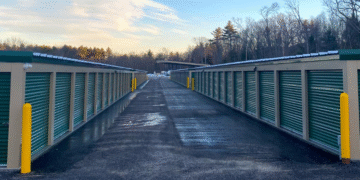As the demand for sustainable practices continues to grow, people are looking for ways to make even the most routine tasks environmentally friendly. Moving across the country can be a resource-intensive process, involving a considerable amount of packing materials. Fortunately, there are several eco-friendly packing solutions and material alternatives that can help reduce environmental impact without compromising the safety of your belongings.
This article explores the best practices and options available for an eco-conscious move.
1. Reusable Plastic Bins
Using reusable plastic bins instead of cardboard boxes is a practical solution for eco-conscious movers. These bins are durable, stackable, and reduce the need for single-use cardboard. Many companies now offer rental services for plastic bins, delivering and picking them up once you’re done, making this option both convenient and sustainable.
Benefits:
- Reduces cardboard waste
- Durable and offers better protection
- Easy to stack and transport
Drawbacks:
- Higher initial cost, though rental options are available
2. Biodegradable Packing Peanuts
Traditional packing peanuts are made of polystyrene, a type of plastic that takes hundreds of years to decompose. In contrast, biodegradable packing peanuts are made from renewable resources like cornstarch and dissolve in water. They’re just as effective for cushioning delicate items and are completely compostable.
Benefits:
- Made from renewable materials
- Easily dissolves in water or composts after use
- Safe for the environment and wildlife
Drawbacks:
- Can be more expensive than traditional packing peanuts
3. Recycled Cardboard Boxes
If you still prefer the convenience of cardboard boxes, choosing recycled cardboard is an excellent way to reduce waste. Recycled boxes are just as sturdy as new ones, and purchasing them supports the recycling industry. For added sustainability, consider getting boxes certified by the Forest Stewardship Council (FSC), which ensures responsible sourcing.
Benefits:
- Reduces demand for new materials
- Widely available and recyclable
- Cost-effective and can often be sourced locally
Drawbacks:
- Still single-use if not repurposed or recycled afterward
4. Eco-Friendly Tape and Labels
Plastic tape and stickers can be challenging to recycle and often end up in landfills. Eco-friendly tape, made from kraft paper or plant-based adhesives, provides a recyclable alternative. This tape can be easily removed or left on when recycling cardboard, streamlining the recycling process.
Benefits:
- Fully recyclable with cardboard boxes
- Easy to tear and use
- Often compostable as well
Drawbacks:
- Typically costs more than traditional plastic tape
5. Upcycled Fabric for Cushioning
Using old towels, sheets, and other fabrics to cushion, pillows and fragile items can save both money and resources. Upcycling these materials offers a dual purpose by reducing the need for bubble wrap and giving your old fabrics new life. After the move, these items can be washed and used again, donated, or repurposed.
Benefits:
- Reduces reliance on bubble wrap and plastic materials
- Cost-effective and can be repurposed afterward
- Soft and gentle on fragile items
Drawbacks:
- Takes more time to gather and prepare than buying standard materials
6. Recycled Paper and Corrugated Rolls
Recycled paper is a versatile and affordable option for wrapping and protecting items. Corrugated rolls, made from recycled paper, provide extra padding for fragile items and are fully recyclable after use. These materials are lightweight and easily compostable, making them ideal for an eco-friendly move.
Benefits:
- Lightweight and compostable
- Affordable and widely available
- Fully recyclable and renewable
Drawbacks:
- Less protective than plastic-based cushioning
7. Rent or Borrow Moving Blankets
For larger items like furniture and electronics, moving blankets are essential for protection. Instead of buying new blankets, consider renting them from moving companies or borrowing them from friends or family. Many rental options are available, and returning the blankets after your move ensures they get reused.
Benefits:
- Reusable and reduces need for new materials
- Provides excellent protection for large items
- Affordable rental options are widely available
Drawbacks:
- Requires additional handling and logistics if renting or borrowing
8. DIY Eco-Friendly Packing Alternatives
If you’re looking to save money and avoid purchasing new packing materials altogether, consider some creative, DIY eco-friendly options:
- Use towels and blankets for cushioning fragile items.
- Save newspapers or magazines for wrapping glassware or filling gaps in boxes.
- Reuse old boxes from local businesses, friends, or neighbors, giving them a second life.
Benefits:
- Cost-effective and sustainable
- Promotes creativity and resourcefulness
- Reduces waste by repurposing readily available items
Drawbacks:
- May take extra time to gather materials

9. Choosing an Eco-Friendly Auto Transport Company
If you’re moving across the country with a vehicle, consider using an eco-friendly auto transport company to further minimize your environmental footprint.
- Look for green practices: Some top rated car shipping companies optimize routes to reduce emissions, use fuel-efficient or hybrid trucks, or offer carbon offset programs that invest in environmental projects.
- Opt for open transport: Open transport, which carries multiple vehicles at once, reduces emissions per vehicle compared to enclosed transport. While open transport offers less protection than enclosed options, it’s generally a more eco-friendly choice.
- Prepare your car: Reduce your car’s weight by removing personal belongings and lowering fuel levels to a quarter tank or less, which minimizes fuel consumption during transport. You can seek help from different guides on how to ship your car.
- Check for carbon offset programs: Many eco-conscious transport companies offer carbon offset programs that help neutralize the emissions from your car’s journey. Ask your auto transport company if they participate in or offer such programs.
By choosing an eco-friendly auto transport company, you align your move with sustainable practices, making the overall relocation process more environmentally conscious. When relocating within California, collaborating with reliable Vehicle Shipping Companies California ensures an eco-friendly and stress-free transport of your vehicle, aligning with sustainable moving practices.
Making Your Move Greener: Additional Tips
In addition to choosing eco-friendly packing materials and auto transport options, consider these additional tips to minimize your environmental impact during a move:
- Declutter beforehand: By donating, selling, or recycling items you don’t need, you’ll reduce the amount you have to pack and transport, saving on materials and fuel.
- Plan for recycling: Research local recycling facilities at your destination and dispose of any unwanted packing materials responsibly.
- Choose a green moving company: Many moving companies now offer eco-friendly practices, like using biodiesel fuel and reusable packing materials.
- Avoid single-use materials: Whenever possible, avoid single-use plastics and look for materials that are biodegradable, recyclable, or reusable.
Conclusion
Moving across the country doesn’t have to be an eco-damaging endeavor. By selecting sustainable packing materials, choosing an eco-friendly auto transport company, recycling responsibly, and opting for reusable options, you can significantly reduce the environmental impact of your move. Taking these small but impactful steps not only contributes to a greener planet but also encourages more sustainable practices for future moves.










